Overview:
Dialogic PowerVille LB is a software-based high-performance, cloud-ready, purpose built and fully optimized network traffic load-balancer uniquely designed to meet challenges for today’s demanding Real-Time Communication infrastructure in both carrier and enterprise applications. The software-based PowerVille LB allows application developers, service providers and enterprises to dynamically scale, distribute and manage traffic associated with a diverse set of real-time and non-real-time applications deployed in today’s networks across disparate applications and datacenters.
Dialogic is recognized as an industry leader in delivering software and virtualization solutions for communications networks. PowerVille LB is yet another advancement by Dialogic in delivering innovative software-based solutions to application delivery (ADC) and network traffic management market segments. PowerVille LB can be deployed across leading commercial off-the-shelf (COTS) server platforms as well as leading hypervisors and cloud platforms. PowerVille LB supports a range of Application and Network services including advanced traffic management, web traffic management, traffic acceleration, encryption offload, protocol interworking and other core network services. The underlying software platform of PowerVille LB enables enterprise and service provider customers to rapidly provision consistent application services across hardware, hypervisor and cloud infrastructure.
PowerVille LB provides a unique combination of intelligent traffic management features that take into account contextual awareness, quality of experience, and session management considerations critical for delivering seamless service in a real-time communications network. PowerVille LB features efficiently manage incoming traffic across application server clusters, significantly reducing application design complexity and improving network performance. High availability, redundancy, and smart failover with call preservation features provide scalability and reliability. Improved resource efficiency coupled with the flexibility of cloud-ready software can translate to lower OPEX and CAPEX for the solution provider. PowerVille LB supports a rich set of services and protocols, facilitating rapid application integration and system interoperability without sacrificing performance.
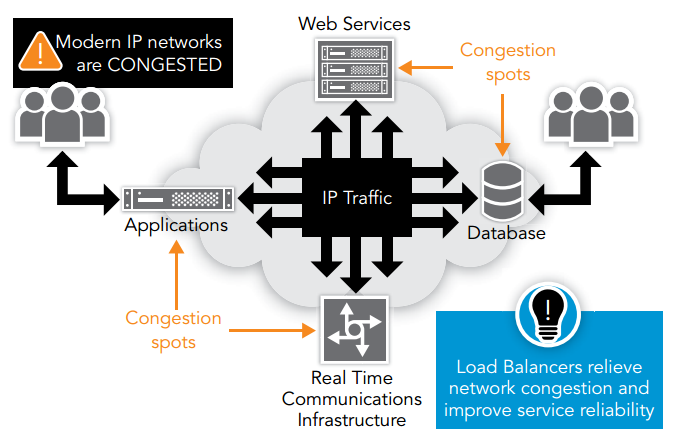
IP communications networks designed to support today’s rich, contextual and immersive communications applications have drastically different and unique sets of requirements that have not previously been seen in IP network design. Today’s Real-Time Communications (RTC) Networks:
- Are highly sensitive to latency and jitter
- Require a high degree of network resiliency and fault tolerance
- Must support multi modal, ad-hoc and encrypted long living sessions
- Need encryption offload – the offloading of encryption overhead from the individual service nodes, helping to improve application performance
- Combine communication infrastructure with authentication, policy management, database access, charging mechanisms and other ancillary functions on IP infrastructure
- Must support service agility to rapidly introduce next generation communication Apps
With a rich legacy of engineering unmatched communication solutions for over 30 years, Dialogic is uniquely positioned to address the needs of the RTC networks with its 100% software-based, cloud-ready PowerVille LB. PowerVille LB supports a rich set of network services and applications without compromising performance. The core functions delivered include:
- Balancing requests from multiple application servers or App server clusters
- Efficient utilization and allocation of incoming traffic across pools of service nodes
- Improving overall application server performance via assistive functions such as traffic grooming, encryption offload, service affinity
- Seamless integration with existing network infrastructure for rapid and quantifiable network impact
- Ease of use, as well as low complexity operations management
Use Cases:
Supporting a wide array of RTC and non-RTC network use cases, PowerVille LB performs commonly used functions of a load balancer such as:
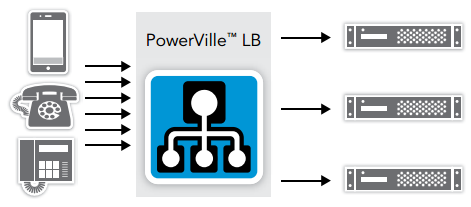 Intelligent Traffic Management
Intelligent Traffic Management
The most common use for a load-balancer is to harness its ability to intelligently distribute traffic associated with a service (e.g., SIP) across one or more available service nodes in the network. Intelligent traffic management is critical in order to provide and preserve service response time and service uptime, and for full utilization of available network resources dedicated to a particular service. PowerVille LB has the ability to steer traffic among available service nodes based on a variety of policies including – Round Robin, Service Node loading and priority, Service awareness (e.g., SIP Connection Affinity) and other advanced techniques. PowerVille LB is a high performance load balancer that can simultaneously process a high volume of all supported services (e.g., HTTP, Database, SIP) while providing that specific service flows are directed to appropriate service nodes responsible for handling traffic related to those service flows.
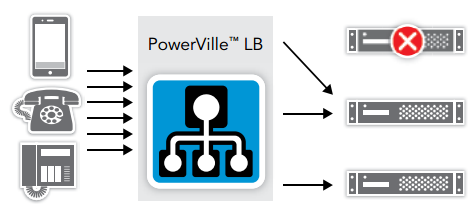 Service Resilience
Service Resilience
One of the key benefits offered by PowerVille LB, is the ability to monitor and track realtime status, availability and service readiness of all the nodes serviced by PowerVille LB. This dynamic service status is fed to the PowerVille LB traffic management algorithms to distribute traffic among available service nodes. This allows networks to self-learn and work around faulty network conditions, preserving service continuity. Incorporating this capability along with optimal network planning and dimensioning principles enables creation of highly resilient networks. Additionally, this capability is highly useful and desirable for scheduled maintenance, network expansion and other routine administrative tasks, without service disruption.
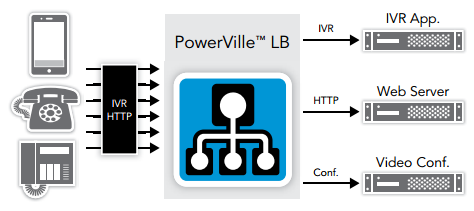 Application Aware Contextual Routing
Application Aware Contextual Routing
PowerVille LB inspects the incoming flows and classifies the flows based on the service type. For some of the key services such as SIP and HTTP, PowerVille LB performs a deeper inspection to extract insights into sessions and transactions. This allows the PowerVille LB to route messages belonging to a particular session and/or transaction to specific service nodes, preserving service continuity. Contextual Routing is beneficial in several use cases. Examples include, always being able to route SIP messages belonging to a conferencing session to the service node hosting that conference, or grouping of HTTP traffic associated with a web transaction to a particular web server.
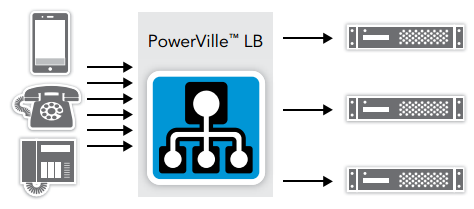 Local and Geographic Redundancy
Local and Geographic Redundancy
PowerVille LB can be deployed in either standalone or redundant configuration. In a redundant configuration, PowerVille LB actively checkpoints and replicates relevant flow descriptors, such that there is no service disruption in case of device or power failure. In a redundant configuration, PowerVille LB can provide redundancy in case of any individual service node outage as described in the Service Resilience section above. In addition, redundant implementations support geographic distribution of the underlying service nodes, and can distribute load across distinct geographic locations, helping to avoid large scale outages should a whole data center fail. Redundant PowerVille LB implementations also support automatic disaster recovery functions, moving flows from one datacenter to another.
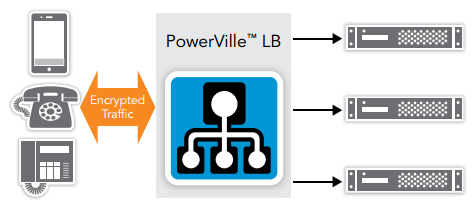 Encryption Offload
Encryption Offload
Increasingly, encryption is becoming a key requirement for securing RTC and non-RTC traffic. For instance, encryption is called for in the emerging WebRTC-enabled communication solutions. Depending on the level of sophistication of the encryption and decryption techniques employed, they can result in a significant computation overhead, causing degraded performance. Further, due to different product upgrade cycle and maturity, all the nodes in a network are unlikely to provide same levels of encryption support. This makes it hard for network administrators to impose uniform encryption requirements across all supported services. PowerVille LB supports an efficient encryption engine designed for processing large volume of encryption traffic. PowerVille LB can be configured to offload encryption overhead from the individual service nodes, which can help to significantly improve application performance. Utilizing PowerVille LB as an encryption anchor point also enables application of uniform encryption standards across supported services.
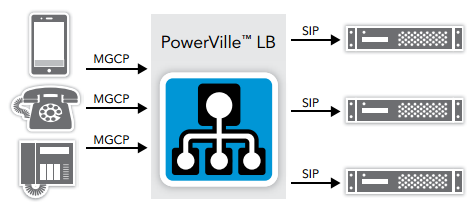 Internetworking
Internetworking
Communication networks often depend on multiple media control protocols, resulting in complex internetworking and integration challenges. A solution to the integration needs of multi-protocol networks, PowerVille LB facilitates protocol conversion, allowing applications to interoperate across protocols. Protocol conversions supported include MGCP and SIP, two of the communication industry’s most popular media control protocols.
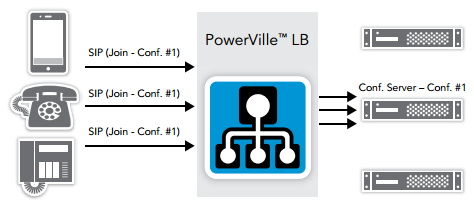 Service Affinity/Traffic Grooming
Service Affinity/Traffic Grooming
Communication applications also often depend on multiple media streams that are part of a common communication session or conference. For the application to operate correctly, the associated media streams must route to a common media server or application. Through Service Affinity and/or Traffic Grooming features, PowerVille LB has the ability to properly route associated media streams to designated media servers or applications.
Example Use Case
PowerVille LB Supporting RTC and non-RTC flows in a Financial Trading Network
The figure below illustrates an example of a complex financial trading network that includes RTC and business critical applications. Such a network supports a large number of financial professionals and helps them to direct their daily trading activities. Users on this type of network routinely use multi-party audio and video conferencing, along with series of web and database applications fully integrated into their trading platforms. In the age of computerized trading, service response time, service uptime and multi-layer resilience are extremely critical for such network applications.

Specifications:
| Technical Specifications |
| Services and Protocols |
- SIP, SIP over TLS
- HTTP and HTTPS
- WebSockets
- Generic TCP Traffic Flows
|
| Protocol Interworking |
Interworking between MGCP and SIP (MSML) |
| Security Features |
- TLS
- Encryption Offload
- Multiple Network Interfaces for traffic separation
|
| Admission Control* |
Codec-based routing |
| Intelligent Traffic Distribution Algorithms |
- Round Robin
- Priority
- Active Nodes (Service Availability)
- Source Address Affinity
- SIP Connection Affinity
- HTTP Cookie Insert
|
| QoS and Statistics |
Real-time call statistics for each managed load balancer |
| Scalability |
- HTTP Transactions per second (state-full): 3800
- HTTP Transactions per second (state-less): 4300
- SIP Calls per second (state-full): 850
- SIP Calls per second (state-less: 2600
|
| Management |
- Integrated web-based management (https) and real-time dashboard and analytics
- SNMP based Alarms
- Java Management Extensions
- Role based User Management
|
| Redundancy |
- 1+1 (active/standby) Redundancy
- Support for Local and Geographic redundancy of service nodes
|
| Virtualization Support** |
VMware ESXi 5.x |
| Hardware Support and Minimum System Requirements |
Hardware: Intel Architecture-based server
- Operating System (64-bit OS): – CentOS Release 6.4 ISO installation OR – Oracle Enterprise Linux 6.4
- Processor: Intel Dual 56xx or greater
- Ethernet: Single or Dual 1000Base-TX (RJ-45)
- Memory: 8 GB RAM minimum
- Storage: 60 GB HD minimum
- Network Interfaces (Recommended)
– Signaling and Media - 1 Gigabit Ethernet (10/100/1000 Base-T)
– Management and High Availability - 1x Gigabit Ethernet (10/100/1000 Base-T)
|
* License Control is a planned feature/function in the area of Admission Control
** KVM and Oracle VM are planned features/functions in the area of Virtualization Support
Documentation:
Download the Dialogic PowerVille LB Datasheet (.PDF)
![]()
![]()